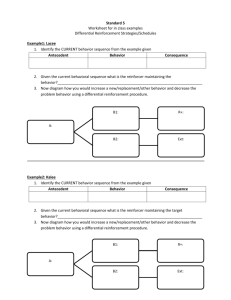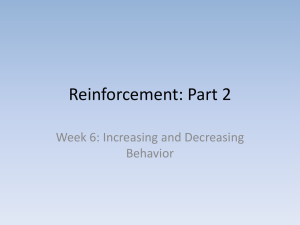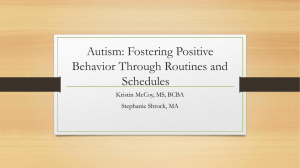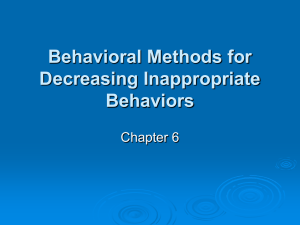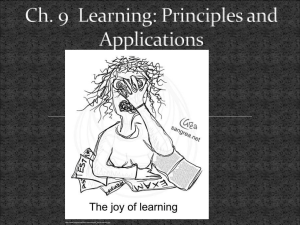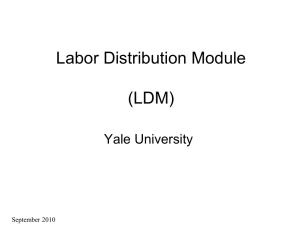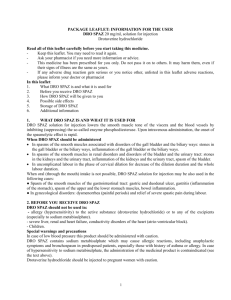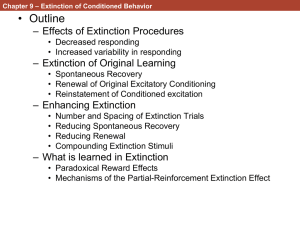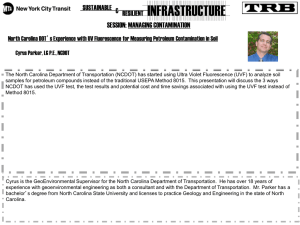Joanna LM schedules of reinforcement
advertisement
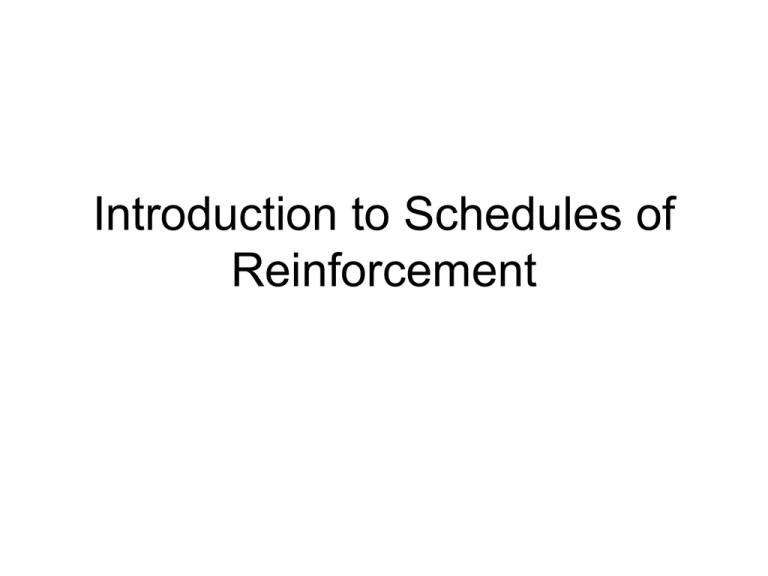
Introduction to Schedules of Reinforcement Who am I? • Joanna Lomas Mevers, PhD, BCBA • 13 years of experience conducting research and clinical treatment using the principles of applied behavior analysis to treat a variety of problem behaviors observed in children Applied Behavior Analysis • Baer, Wolf, & Risley, (1968) – Applied – Behavioral – Analytic – Technological – Conceptually Systematic – Effective – Generalizable Applied Behavior Analytic Research – Applied • “Teaching teenagers with autism to seek assistance when lost” • “Teaching safety skills to children to prevent gun play” • “Delay discounting by pathological gamblers” • “Social antecedents of children’s eyewitness testimony” • “A half century of scalloping in the work habits of the United States Congress” A Day in the Life of a Behavior Analyst • Universities – Professors, researchers • Education – Consultants, school psychologists, special educators • Industry – Safety/efficiency consultants, sports psychologists, military consultants • Private practice psychologists – Counselors, parent training specialists • Healthcare – Pediatric and developmental psychologists • Miscellaneous – animal trainers, social behavior specialists Behavior Problems with a History of Successful Treatment by Behavior Analytic Interventions • • • • • • • • • • • • • Phobias Obsessive-compulsive disorder Speech delays Paraphillias Self injury Aggression Property destruction Pica Conduct disorders (i.e., juvenile delinquency) Eneurisis/econpresis Inattention/impulsivity Feeding disorders Rumination A few of the tools? • • • • Schedules of Reinforcement Punishment Motivation Stimulus Control Why Study Schedules of Reinforcement?? • As behavior analyst this is one of the most important tools we have to change behavior Patterns of Behavior • “The outstanding characteristic of operant behavior is that it can be differentiated in form and in temporal patterning by consequent events.” -Morse, 1966 Patterns of Behavior • Behavior is very, very complex---but: – Behavior is not chaotic or without causes – This means there can be a science of behavior – There are orderly patterns to behavior – These patterns are induced, in part, by contingencies CUMULATIVE STUDY TIME FOR TEST T Operant Conditioning W Th F S Su M T Important Variables to Consider • Motivation • Individual differences • Reinforcement • Punishment • Stimulus Control • Discrimination • Generalization • Match–to-sample Three-Term Contingency 1. Operant class (Ro) 2. Discriminative Stimulus (SD) 3. Reinforcing Consequences (SR) Schedule Classification • Response dependent and independent • Which one is Pavlovian? Response Independent • Fixed-time • Random time • Extinction Response Dependent Schedules • Ratio • Interval • DRO Fixed Ratio (FR) Schedule • Definition: A response is reinforced when a fixed number of responses have been emitted since the last reinforcer. Fixed-ratio cumulative record: FR PERFORMANCE 100 \ \ 80 CUMULATIVE RESPONSES \ \ \ \ \ \ \ \ \ \ 40 \ 20 \ 100 200 TERMINAL RUN REINFORCER \ \ \ \ \ \ \ \ 0 \ \ \ \ \ 60 \ 300 PAUSE AFTER RFT \ \ \ 400 TIME Simple schedules and feedback functions 500 600 18 Fixed Ratio (FR) Schedules: Independent Variables • The terminal run -- insensitive • The pause-after-reinforcement -- sensitive to many independent variables – – Deprivation – Punishment – Ratio requirements Fixed Ratio (FR) Schedules • Extinction after FR training: – Burst-and-break pattern, pauses getting longer, runs getting shorter Variable Ratio (VR) Schedule • Definition: A response is reinforced when a number of responses that varies around some average have been emitted since the last reinforcer • Range of responses varies: – VR 30 could be M = 30 (1-60) or M = 30 (28-32) Variable-ratio cumulative record: VR PERFORMANCE 100 \ CUMULATIVE RESPONSES \ 80 \ REINFORCERS 60 \\ 40 \ 20 \ 0 100 200 300 TIME 400 500 600 22 Variable Ratio (VR) Schedules: Independent Variables & Extinction • Insensitive to most independent variables – Performance breaks up under • Very low levels of deprivation • Very high response requirements • Extinction after VR training: – Burst-and-break pattern – VR performance takes longer to extinguish than FR performance Not a VR schedule • Some say playing slot machines and other gambling activities are reinforced on a VR schedule •This is “the gambler’s fallacy – each response increases the probability of the next response being reinforced •These activities actually operate on a random ratio schedule Fixed Interval (FI) Schedules • Definition: A response is reinforced when a fixed period of time has elapsed since the last reinforcer (or event). Scalloped pattern – low rate after reinforcers, accelerates to a high rate before the next reinforcer. Fixed-Interval (FI)1-min. Fixed Interval (FI) Schedules: Independent Variables & Extinction Independent variables • Quite sensitive to many independent variables -drugs, deprivation, punishment, etc Extinction • Steady decrease in response rate. Overall, extinction takes much the same time as an FR performance with the same reinforcer rate. Variable Interval (VI) Schedules Definition: A response is reinforced when a period of time that varies around some mean has elapsed since the last reinforcer (or event). High, constant rate of responding with few pauses. But not as high as VR VI-SCHEDULE PERFORMANCE 100 \ \ \ CUMULATIVE RESPONSES 80 \ \ 60 \ \ \ 40 \ 20 0 0 100 200 300 TIME 400 500 600 Variable Interval (VI) Schedules: Independent Variables & Extinction Independent variables • Quite sensitive to various independent variables -- reinforcer rate, reinforcer magnitude, deprivation, punishment, and drugs. Extinction • Smooth and progressive decline in response rate until the behaviour is eliminated (just like extinction after FI training). But VI performance takes a longer time than FI to extinguish. Differential Reinforcement of Other Behavior (DRO) • Definition: A reinforcer is delivered when a defined response has not been emitted for a fixed period of time. • Note that the delivery of the reinforcer is not contingent on a particular response being emitted. Differential Reinforcement of Other Behavior (DRO) Example: A child is given a sweet after not showing any tantrums for a minute (DRO 60 s). If no more tantrums are emitted, a sweet is given every minute. • Notice that, in DRO schedules, the contingency is on the complement of the defined response -on not lever pressing, or not key pecking, or not emitting tantrums. Differential Reinforcement of Other Behavior (DRO) • 2 types: – Resetting: each time the behavior that is targeted for reduction occurs the timer resets – Non-resetting: the timer runs its course each time, and the behavior is either reinforced (or not) depending on whether it has occurred in that interval Differential Reinforcement of Other Behavior (DRO) • Comment: DRO schedules are sometimes also called omission training and (really confusingly) negative punishment schedules. Avoid the latter two. • Used extensively to eliminate unwanted behavior: • quicker than simply extinguishing the behaviour • extinction sometimes increases the unwanted behavior briefly, and can also lead to aggression • Ethically more acceptable than punishment procedures (although they may take longer to have the desired effect). Differential Reinforcement of Other Behavior (DRO) • Comment #2: DRO schedules are not actually reinforcing the absence of a behavior (you can’t reinforce nothing). • Rather, any other behavior that happens to be occurring when the contingency is met increases, displacing the behavior that is targeted for decrease • In this way, what type of schedule is most similar to a DRO? Which Would You Use? • Out of FR, VR, FI, VI • To get the highest rate of responding? • When you want a behavior to be resistant to extinction? • For the fastest extinction? • Teach a new response?
